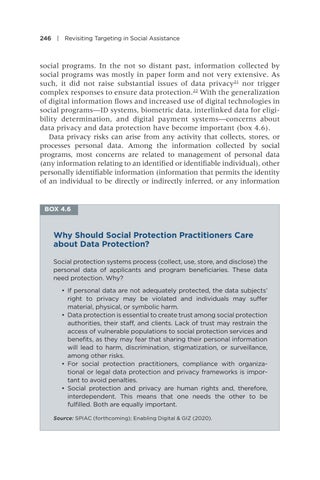246 | Revisiting Targeting in Social Assistance
social programs. In the not so distant past, information collected by social programs was mostly in paper form and not very extensive. As such, it did not raise substantial issues of data privacy21 nor trigger complex responses to ensure data protection.22 With the generalization of digital information flows and increased use of digital technologies in social programs—ID systems, biometric data, interlinked data for eligibility determination, and digital payment systems—concerns about data privacy and data protection have become important (box 4.6). Data privacy risks can arise from any activity that collects, stores, or processes personal data. Among the information collected by social programs, most concerns are related to management of personal data (any information relating to an identified or identifiable individual), other personally identifiable information (information that permits the identity of an individual to be directly or indirectly inferred, or any information
BOX 4.6
Why Should Social Protection Practitioners Care about Data Protection? Social protection systems process (collect, use, store, and disclose) the personal data of applicants and program beneficiaries. These data need protection. Why? • If personal data are not adequately protected, the data subjects’ right to privacy may be violated and individuals may suffer material, physical, or symbolic harm. • Data protection is essential to create trust among social protection authorities, their staff, and clients. Lack of trust may restrain the access of vulnerable populations to social protection services and benefits, as they may fear that sharing their personal information will lead to harm, discrimination, stigmatization, or surveillance, among other risks. • For social protection practitioners, compliance with organizational or legal data protection and privacy frameworks is important to avoid penalties. • Social protection and privacy are human rights and, therefore, interdependent. This means that one needs the other to be fulfilled. Both are equally important. Source: SPIAC (forthcoming); Enabling Digital & GIZ (2020).


